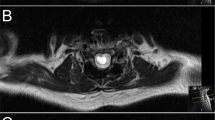Abstract
The establishment of a new technology into the mainstream of treatment, such as spinal surgery for traumatic spinal cord injury, only rarely happens after being scrutinized in trials. Usually, a new technology is widely adopted when it offers an easily identifiable advantage over other treatment choices. In the case of spinal fixation, this advantage is the omission of a prolonged immobilization. However, this does not automatically preclude that the final outcome of the treatment is better. It does not imply that associated assumptions, such as the benefit of early decompression toward neurological improvement, are true as well. They need to be established with careful studies.
Similar content being viewed by others
The point and counterpoint given by Kaye and Vaccaro on one side and El Masri remind the reader that no treatment choice should be adopted with a clear picture of possible disadvantages and the knowledge that most of the time there is a choice.
Spinal surgery for spinal injury with neurologic deficit is the standard of care today. In the paper of Kaye and Vaccaro relevant information of the current medical opinion is given. There seems to be no need for any further discussion. The focus of future research may be the timing of surgery not the surgical decompression and stabilization as such.
But there is a minority of clinicians who object. They raise the question on what scientific basis the decision was made that surgery should be performed in these cases. Was there proof for a clinical benefit or was the indication to perform spinal stabilization just expanded as the technical possibilities improved and as in the case of the United States regulatory institutions permitted the use these implants? Iconoclastically, as some spine surgeons will call it, Waghi El Masri maintains that he is not convinced.
In his statement, he emphasizes that the secondary trauma, which is happening to the spinal cord during surgery will further create further harm. In his judgment, he rates the additional risk as greater than the benefit gained by decompression. In this regard, he has certainly has a point. Alternatively, other suggestions, such as the notion that early mobilization causes harm have, at least to my knowledge, never been systematically addressed but do not resonate with the clinical experience of the current practice.
Even if surgical treatment is the generally accepted standard of care, surgery always comes with the risk of complications, to a lesser degree for the experienced surgeon, more likely if a less-experienced person is doing the procedure in the dead of the night. As for the secondary trauma caused by surgery, there is no good data. There is no study that links indicators of a more severe secondary trauma, such as duration of surgery and blood loss to neurologic outcome. But even without a study we know that again experience plays a big role in this regard.
It will not possible to bring each patient into a well-equipped center within a short time. To omit or postpone surgery and remain—at least for some time—conservative is most likely a very good choice in some cases. This has to be kept in mind especially if and when we come to the point that the logical consequence of our animal data is very early decompression. If we cannot prove this concept, we best not advocate a surgical solution, which will inevitably lead to suboptimal surgery performed under the rationale of rapid decompression.
Furthermore, the clinical observations call for surgical procedures as minimally invasive as possible. Over the last years there has been a tendency to fuse longer and longer parts of the spine, abandoning the initial strategy to obtain a stable fusion as short as possible. This trend has to be reversed.
There should be no clash of two worlds. On one side, we have the spine surgeon who sees the patient in clinical routine only very limited time, on the other hand we have the view of the clinician who sees the patient during the whole course of the often painfully slow recovery. Both have to listen. Spinal fusion is the standard of care today because almost nobody will accept the long period of immobilization needed for conservative treatment. However, surgeons have to accept that surgery is not an end in itself and therefore has to be tailored to meet the need of the conservative treatment of the injury of the spinal cord and the neurologic deficiency. Spine surgeons are well advised not to forget that they fix the spine—not the spinal cord.
Author information
Authors and Affiliations
Corresponding author
Ethics declarations
Conflict of interest
The author received consultation fees from Depuy-Synthes for work on an advisory board for pediatric scoliosis treatment.
Rights and permissions
About this article
Cite this article
Abel, R. Surgery for spinal injury with neurologic deficit: a matter of opinion?. Spinal Cord Ser Cases 4, 16 (2018). https://doi.org/10.1038/s41394-018-0048-9
Received:
Accepted:
Published:
DOI: https://doi.org/10.1038/s41394-018-0048-9
This article is cited by
-
Clinical outcome of closed reduction of cervical spine injuries in a cohort of Nigerians
Spinal Cord Series and Cases (2019)
-
Awards and updates
Spinal Cord Series and Cases (2018)



